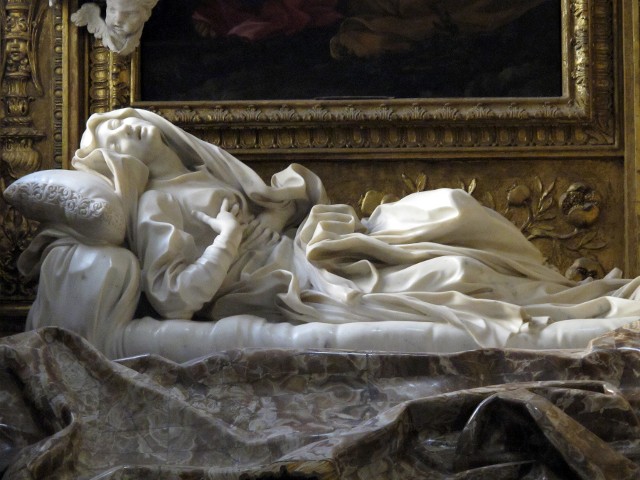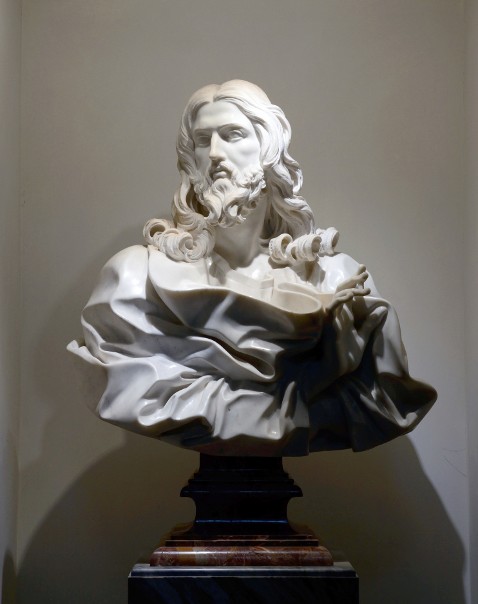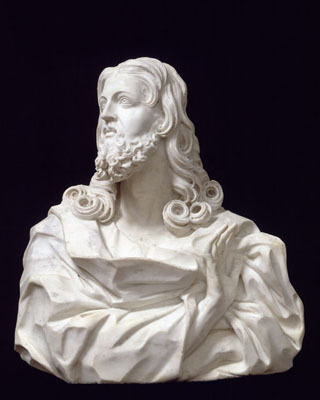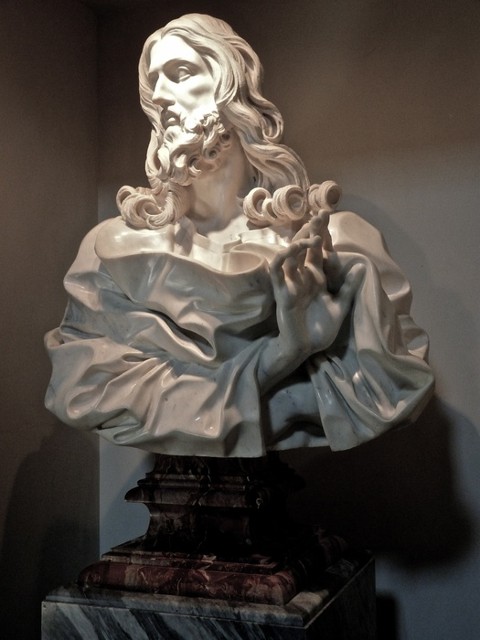|
|
Tranfigurations: Bernini's Last Works

Click link:
http://www.scribd.com/doc/219531064/Transfigurations-Bernini-s-Last-Works-by-Charles-Scribner-III
|

For newly discovered Bust of the Savior in San Sebastiano, colorplate 42 in revised edition, click link: http://www.scribd.com/doc/253784039
In his final sculpture the eighty-year-old maestro “summarized and condensed all his art,” Domenico writes, adding that his father’s “bold conception” more than compensated for the “weakness of his wrist.” Bernini undertook this parting work not for his own tomb, a plain marble slab in Santa Maria Maggiore, but as a gift to Rome’s preeminent convert, Queen Christina of Sweden. When she refused to accept it, claiming that she could never afford to repay Bernini for its true worth, he bequeathed it to her. On his deathbed he asked for Christina’s prayers since she shared “a special language with God.” It was precisely through Bernini’s special language of gesture and facial expression that his otherworldly “speaking portrait” of the Risen Lord communicates its meaning.
The bust was originally mounted on a Sicilian jasper base and supported by two angels kneeling on a gilded wooden socle. Bernini’s sketch (Museum, Leipzig) for the pedestal reflects his drawing (also in Leipzig) of similar angels elevating a monstrance to display the sacramental Body of Christ. Bequeathed by Christina to Pope Innocent XI, Bernini’s Savior was later adapted as the official emblem of the Apostolic Hospital in Rome before vanishing in the late eighteenth century. Only a preliminary drawing in Rome preserved Bernini’s redeeming image until Irving Lavin published in 1972 this marble in Norfolk, 
Virginia, as the lost bust. This was followed a year later by the discovery, in the cathedral of Sées, of the copy commissioned by Bernini’s Parisian friend Pierre Cureau de la Chambre. While the latter bust reveals a classical beauty and polish typical of a competent copyist, the Norfolk version, on the other hand, appears almost Gothic by comparison and it remained puzzling, even if accepted by most scholars. The recent rediscovery, four decades later, of Bernini’s lost original marble in the sacristy of San Sebastiano Fuori le Mura in Rome  (and authenticated by Professor Lavin) confirms that the Norfolk bust represents in fact an inexact copy (perhaps dating from the late 18th century); the bust at San Sebastiano, now brilliantly displayed in a grand niche near the entrance of the church, reveals in full glory Bernini’s magnificent sunset in marble. It is well worth the pilgrimage along the Appian Way. (and authenticated by Professor Lavin) confirms that the Norfolk bust represents in fact an inexact copy (perhaps dating from the late 18th century); the bust at San Sebastiano, now brilliantly displayed in a grand niche near the entrance of the church, reveals in full glory Bernini’s magnificent sunset in marble. It is well worth the pilgrimage along the Appian Way.
The unusual gesture that Lavin interpreted as an ambiguous combination of “abhorrence and protection” may recall the Noli me tangere: “Do not touch me, for I have not yet ascended to the Father” (John 20:17). Evoked through Christ’s aloof visage and raised hand — an unexpectedly oblique benediction — this biblical allusion would have been reinforced by the angels that, with hands covered, lifted the divine effigy above the touch of mortals. When designing a symbolic globe to raise his Louis XIV in a royal apothe¬osis, he explained that its practical function was to prevent viewers from touching the bust. But the surface meaning of the gesture here was described by Domenico (who surely knew what his father intended) as “the act of blessing.” Thus the maestro of movement left as his parting tour de force not an iconic Christ with hand symbolically raised in a static, formal benediction, but a dynamic divine figure caught at the moment he is about to complete the horizontal sweep of the cruciform gesture, a moment familiar to every Catholic who has attended Mass. In the end, as in the youthful David, it is all about movement. Viewed afresh, the Savior may finally come into focus as a sacramental apotheosis: a huge white Host elevated as “the Bread of Angels,” Bernini’s sacrament in stone.
Gianlorenzo’s career commenced with the posthumous bust of Bishop Santoni, a public effigy; seven decades later, it concluded with a private bust of the Savior, animated through marble folds that follow no natural pattern. The striking realism of the child prodigy was in the end transfigured by this genius for whom life and art were as inseparable as fact and faith.
|
no Fuori le Mura in Rome (and authenti
|
|
BUST OF THE SAVIOR
1679-80 Marble, height 106 cm
San Sebastiano Fuori le Mura, Rome
In his final sculpture the eighty-year-old maestro “summarized and condensed all his art,” Domenico writes, adding that his father’s “bold conception” more than compensated for the “weakness of his wrist.” Bernini undertook this parting work not for his own tomb, a marble slab in Santa Maria Maggiore, but as a gift for Rome’s preeminent Catholic convert, Queen Christina of Sweden. When she refused to accept it, saying she could never afford to repay Bernini for its true worth, he bequeathed it to her. On his deathbed he asked for Christina’s prayers since she shared “a special language with God.” It was precisely through Bernini’s special language of gesture and facial expression that his otherworldly “speaking portrait” of the Lord communicates its meaning.
The bust was originally mounted on a round Sicilian jasper base and supported by two angels kneeling on a gilded wooden socle. Bernini’s sketch (Museum, Leipzig) for the pedestal reflects his drawing (also in Leipzig) of similar angels elevating a monstrance to display the sacramental Body of Christ (compare fig. 68). Bequeathed by Christina to Innocent XI, Bernini’s Savior was later adapted as the official emblem of the Apostolic Hospital in Rome before vanishing in the early eighteenth century. Only a preliminary drawing (fig. 70) preserved Bernini’s redeeming image until Irving Lavin published in 1972 the marble in Norfolk, Virginia, as the lost bust.77 This was followed a year later by the discovery, in the cathedral of Sées, of the copy commissioned by Bernini’s Parisian friend Pierre Cureau de la Chambre. While the latter bust reveals a classical beauty and polish typical of a competent copyist, the Norfolk version, on the other hand, appears almost Gothic by comparison, and it remained puzzling even if accepted by most scholars. The recent rediscovery, four decades later, of the lost original in the sacristy of San Sebastiano Fuori le Mura in Rome confirms—as Lavin himself attests--that the Norfolk bust is in fact a copy
(perhaps dating from the late 18th century); the bust at San Sebastiano, now brilliantly displayed in a grand niche in the basilica proper, reveals in full glory Bernini’s magnificent sunset in marble. It is well worth the pilgrimage along the Appian Way.
Clearly no simple blessing, the unusual gesture that Lavin interpreted as an ambiguous combination of “abhorrence and protection” may, more precisely, refer to the Noli Me Tangere — the first appearance of the resurrected Christ to Mary Magdalene: “Do not touch me, for I have not yet ascended to the Father” (John 20:17). Evoked through Christ’s aloof visage and raised hand — an unexpectedly cautionary benediction — Bernini’s biblical allusion would have been reinforced by the angels that, with hands covered, lifted the divine effigy above the touch of mortals. When designing a symbolic globe to raise his Louis XIV in a royal apotheosis, he explained that its practical function was to prevent viewers from touching the bust. Considered afresh in its original context, as a sacramental apotheosis, the Savior may finally come into focus. The features that seem exaggerated up close, together with the tumultuously abstracted drapery folds and the blank eyes of classical Roman portrait busts, are resolved into an expression of enormous spiritual intensity when viewed from below. Its concetto is emphatically Eucharistic — a huge white Host elevated as “the Bread of Angels.” This is Bernini’s marble sacrament, raised in his last labor of adoration.
According to his biographers, Gianlorenzo’s career commenced with the posthumous bust of Bishop Santoni, a public effigy (plate 1); seven decades later, it concluded with a private bust of the Eternal Savior, animated through marble folds that follow no natural pattern. The striking realism of the child prodigy was transfigured, in the end, by the ethereal vision of a genius for whom life and art were as inseparable as fact and faith.
|
|
|

![]()

![]()
![]()
![]()
![]()
